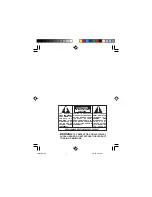
2
CEILING
MINIMUM
50CM(20")
WALL
never here
acceptable
location
center of ceiling
best location
0.9M(3ft)
horizontal distance from peak
Figure 3
Figure 4
de
tec
tor
WHERE NOT TO INSTALL SMOKE ALARMS
• Nuisance alarms take place when smoke detectors are installed where they will not
work properly. To avoid nuisance alarms, do not install smoke detectors in the following
situations:
• Combustion particles are the by-products of something that is burning. Thus, in or near
areas where combustion particles are present you do not install the smoke detectors to
avoid nuisance alarms, such as kitchens with few windows or poor ventilation, garages
where there may be vehicle exhaust, near furnaces, hot water heaters, and space
heaters.
• Do not install smoke detectors less than 6 meters away from places where combustion
particles are normally present, like kitchens. If a 6 meters distance is not possible, e.g. in
a mobile home, try to install the detector as far away from the combustion particles as
possible. To prevent nuisance alarm alarms, provide good ventilation in such places.
• In damp or very humid areas, or near bathrooms with showers. Moisture in humid air
can enter the sensing chamber, then turns into droplets upon cooling, which can cause
nuisance alarms. Install smoke detectors at least 3 meters away from bathrooms.
• In very cold or very hot areas, including unheated buildings or outdoor rooms. If the
temperature goes above or below the operating range of smoke detector, it will not work
properly. The temperature range for your smoke detector is 4 °C to 38 °C.
• In very dusty or dirty areas, dirt and dust can build up on the detector’s sensing chamber,
to make it overly sensitive. Additionally, dust or dirt can block openings to the sensing
chamber and keep the detector from sensing smoke.
• Near fresh air vents or very drafty areas like air conditioners, heaters or fans, fresh air
vents and drafts can drive smoke away from smoke detectors.
• Dead air spaces are often at the top of a peaked roof, or in the corners between ceilings
and walls. Dead air may prevent smoke from reaching a detector.
• In insect-infested areas. If insects enter a detector’s sensing chamber, they may cause
a nuisance alarm. Where bugs are a problem, get rid of them before putting up a
detector.
• Near fl uorescent lights, electrical “noise” from fl uorescent lights may cause nuisance
alarms. Install smoke detectors at least 1.5 meters from such lights.



































